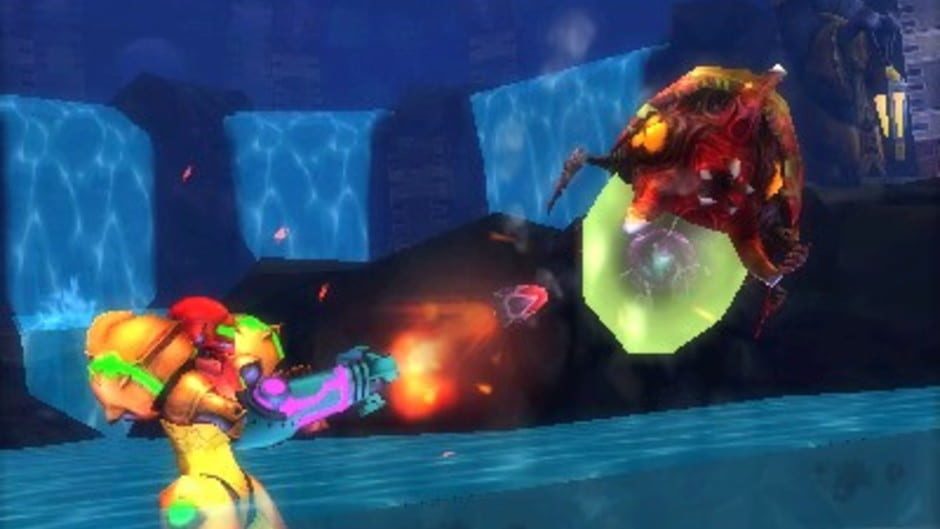Metroid: Samus Returns is a remake of Metroid II: Return of Samus, the first portable entry in the influential series. Both have the same premise: After the events of the first Metroid videogame, the Galactic Federation decides the parasitic Metroid species is too dangerous to exist and hires bounty hunter Samus Aran to exterminate the last of them. Players guide Samus from the surface of the planet SR-388 down to its depths, wiping out each region’s Metroid population before unlocking the next, culminating in a battle with the final Metroid Queen. This simple concept is its strength, especially on the lower-powered Game Boy system. But Samus Returns reuses the concept without understanding its execution, resulting in a confused remake searching for a reason to exist.

A good videogame remake can distinguish itself in two ways. The first is a meticulous recreation of the original environment using contemporary design techniques and hardware; the 2019 remake of The Legend of Zelda: Link’s Awakening is a good example, copying the original level design square-for-square but with a seamless overworld, chibi-inspired polygonal graphics, and an orchestrated soundtrack. The second is an ambitious reimagining that honors the spirit of the original but creates a new environment and adorns it with embellishments that weren’t possible when the original was made; the 2001 remake of Resident Evil is the best example, recalling the 1996 original but expanding and improving in so many ways it has consumed the original in popular consciousness.
Samus Returns is not a meticulous recreation. It has a new environment which sprawls in defiance of the original’s constraint. Samus’ abilities are bloated beyond a beam-and-missile combo; multiple beam types are stacked on top of each other, joining Super Missiles, Power Bombs, and four new Power Suit abilities, all activated by frenzied tapping of the cramped D-Pad and touchscreen. The sheer number of different projectiles and explosives creates too many unique barriers to block Samus’ path, making the overlarge map still larger.
This remake assumes the elegant simplicity of the original, necessitated by the limited storage space and power of the Game Boy, are errors to be corrected and not inspirations to be embraced.

Samus Returns also is not an ambitious reimagining; if you’ve played any other Metroid videogame or an imitator then you know what to expect here. Samus begins her mission with a basic energy weapon and no-frills Power Suit, but accumulates a myriad of alternate energy weapons, explosives, and Power Suit upgrades, each opening previously-inaccessible paths. This familiarity gives a comfort food quality, and if all you’re looking for is another exploration-heavy platformer it will not disappoint. But the series’ core gameplay loop becomes lost in a bland map that fails to differentiate SR-388’s areas from each other specifically or from any other series entry generally.
This remake assumes it can slide by on virtue of being an ordinary Metroid videogame while offering little to stand out from the many, many Metroid-inspired videogames which have arrived in the past twenty years.
To give credit where it’s due: Samus Returns adds a counter attack system to the series formula. Enemies will now flash and emit a telltale “click” before certain attacks. If I react to these tells with the X button, Samus will stun the charging creature with a sweep of her arms, leaving it vulnerable to a suddenly-supercharged arm cannon blast. This addition, expanded from a similar but abstruse system in Metroid: Other M, adds physicality to Samus’ projectile-heavy offensive repertoire. But early on counter attacks feel like a crutch—so powerful they makes regular attacks seem pointless—and later on so many enemies are immune that I quit using it. By that point, Samus’ arm cannon had become so powerful again I didn’t miss it. It’s an exciting new system, but diluted by overuse at the outset and squandered by over-specialty at the endgame.

The star of Samus Returns are the Metroids. Already fearsome opponents in Return of Samus, the remake transforms each one into a vicious battle requiring all of Samus’ skill and weaponry. Even the first Metroid I defeated took several attempts to learn its behavior, and three more new and deadly varieties of Metroid appear as their numbers dwindle. As the only Metroid series title to set the Metroid species as its central conflict and menace, all of the 3DS’ hardware power is used to create the most thrilling battles with these life-sucking space squids seen yet.
But while each new encounter is challenging and rewarding, repetition sets in when the goal is to hunt down and kill fifty of them. I felt a satisfying sense of continuity when a Metroid variety that challenged me at the start I learned to put down in seconds by the end, but it is joined by tedium. Including the ultimate Metroid Queen, there are only three unique boss encounters, and each is so well-designed it makes me wonder what else the developers could have come up with to milestone Samus’ mission other than Alpha Metroid Fight Number 20. This one carryover from the original’s simple approach is what bogs the remake down most.

Metroid II: Return of Samus was already a troubling videogame, its goal to hunt an endangered non-sentient species into extinction on the payroll of a galactic government we never learn much about. But its simple concept and abbreviated design made it ideal for portable play and unique in the series. Metroid: Samus Returns does not understand this, stuffing Samus with too many abilities and setting her loose in a meandering world. It fades into the swell of other adventure-platformers, muted and obligatory, never justifying why Return of Samus needed a remake in the first place.